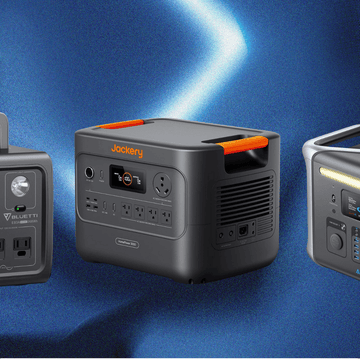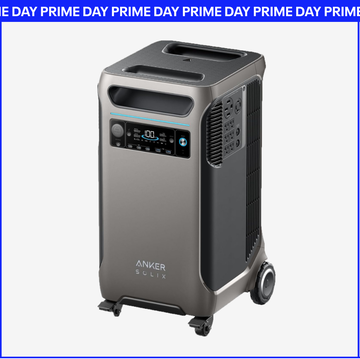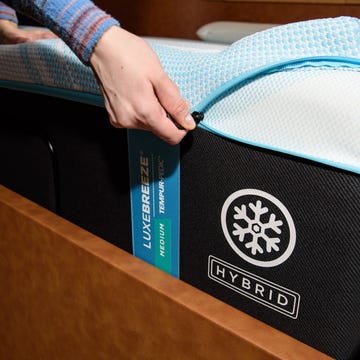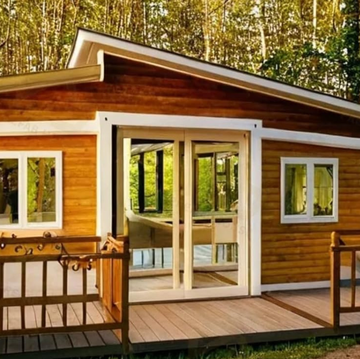The options for keeping your home running during a power outage used to be limited to gas — either a portable generator that runs on regular unleaded gasoline or a standby generator that uses natural gas or propane.
But in the last few years another solution has entered the marketplace: portable power stations, also known as solar-powered generators, since they can be charged by the sun. In this article, our experts from the Home Improvement & Outdoor Lab at the Good Housekeeping Institute talk through the key differences so that you can decide which backup power solution makes the most sense for you.
How do gas generators work?
At the heart of both portable and standby gas generators is an internal combustion engine that runs on fuel to produce energy that is transferred to electronic components in the home.
Portable Generators
Portable generators run on regular gasoline from the gas station, just like a car or lawn mower. Because they're portable, they're common on construction sites, camp grounds and the like as a source of on-demand power. You need to turn them on manually and then plug whatever you want to keep running into their onboard outlets. Power output typically ranges from 3,000 to 8,000 watts.
Pros
- Relatively inexpensive
- Provide decent power output
- No installation required
- Portable design means they can be taken anywhere
Cons
- Require a steady supply of gas
- Must be used outdoors to prevent deadly fumes from entering the home
Cost
- $500 to $2,000.
Standby Generators
Standby generators are powered by a local supply of gas — either propane (from a tank in the yard) or natural gas (from a standard utility line, same as a gas-fired furnace, water heater or dryer). That means you don’t have to worry about stocking up on fuel with a storm bearing down. Standby generators must be professionally installed, at a cost ranging between $5,000 and $18,000, according to ANGI, the home services marketplace; figure on an additional few hundred dollars in annual maintenance.
Standby generators are installed with a transfer switch that turns them on automatically the moment the home loses power; the switch connects to specific circuits in the home, like the ones controlling the furnace, refrigerator or sump pump, so they will maintain power for the duration of the outage. Standby generators typically provide between 10,000 and 20,000 watts of power.
Pros
- Can generate enough power for an entire home.
- Turn on automatically when power goes out.
- Run on a steady supply of propane or natural gas.
Cons
- Steep upfront cost.
- Professional installation and maintenance required.
Cost
- $5,000 to $18,000, including installation.
How do solar generators work?
A solar generator is essentially a big rechargeable battery that powers other electronic devices. They're a quiet, emissions-free source of power that can safely be used indoors. Smaller units weigh under 50 pounds, making them portable, too.
Many generators use lithium-ion battery technology, common in power tools, though we’re starting to see models in the Lab that run on lithium iron phosphate (LiFePO4) and solid-state batteries, both of which charge up faster (two hours or less) and hold their charge for up to one year. Power output starts as low as 200 watts for mini power stations and goes up to 6,000 watts for larger units, which can then be scaled as high as 50,000 watts or more by adding on more batteries.
Regardless of the battery type, all generators need to be charged and recharged after their power is drained by other electronics. The fastest way to do this is by plugging them into a standard wall outlet, though you can also charge them off a car battery or with the use of portable solar panels.
Solar Generators
Pros
- Safe, emissions-free source of backup power
- Quiet operation
- Often portable enough for camping and construction sites
Cons
- Most models need to be turned on manually
- Newer technology is less familiar to electricians and other service pros
Cost
- $1,000 to $6,000 for equipment
- Installation of a whole-house system could add $2,000 to $3,500 to the project cost
How we test solar and gas generators
Our product experts closely monitor the generator market, tracking popular models and the latest innovations by attending trade shows like the Consumer Electronics Show (CES) and the National Hardware Show.
Hands-on testing takes place both in our Lab and in the homes of consumer testers over the course of several weeks. Here's what we look at:
Capacity
- We test claimed capacity by running electronic devices with corresponding energy loads (e.g., 1,500-watt heaters for large-capacity, laptops for small-capacity) in our Lab.
- Consumer testers measure solar charge times of portable power stations and capacity under real-world conditions at home.
- Our engineers review technical data to confirm shelf life (how long charge is held) and lifecycle (number of recharges).
Charge Time
- With solar models, we verify claimed charging times using solar panels and AC wall outlets in our Lab.
Usability
- We check the total number of outlets to gauge how many devices can be charged simultaneously.
- We assess user-friendly features such as carrying handles, wheels, LED lights and onboard storage.
Durability
- We test durability of both the generator and solar panels for long-term performance.
Solar vs. gas: How to decide
Now that you know the basics of solar versus gas generators, how do you make the final decision? As with so many aspects of home maintenance, there’s no one-size-fits-all solution here. Weighing the following factors should help you make the right choice:
Power capacity
Are you looking for a solution that will keep your entire home running through an extended power outage? Or is it enough to power a few essentials, say the fridge and furnace? Or are your power needs even less, like keeping the DJ going during a backyard barbecue or tailgate party? Our experts have tested generators with capacities as low as 200 watts and as high as 20,000 or more.
Here’s a look at how many watts various devices in the home will use in approximately one hour.
- Air compressor: 800–1,000 watts per hour
- Air conditioner (window and portable): 1,000–1,500 watts per hour
- Breast pump: 20–50 watts per hour
- Cell phone: 2–10 watts per hour
- CPAP machine: 40–50 watts per hour
- Electric drill: 500–900 watts per hour
- Fan: 50–100 watts per hour
- Laptop: 30–100 watts per hour
- Lighting: 10–50 watts per hour
- Refrigerator: 100–200 watts per hour
- Space heater: 800–1,500 watts per hour
- Sump pump: 750–1,500 watts per hour
- TV: 50–250 watts per hour
- Wi-Fi router: 2–20 watts per hour
If your power needs will stay below 3,000 watts, a solar generator probably makes the most sense. For between 3,000 and 8,000 watts, consider a portable gas generator or an extra-large solar generator. If you need 10,000 watts or more, standby gas generators start to make the most sense, though there are scaleable whole-house solar-powered solutions that can get the job done.
Keep in mind that overloading a generator can damage the device itself, as well as any connected electronics. It's important to think about run time, or how long you will need to power each device. To keep a 200-watt refrigerator running for 10 hours, you'll need a 2,000-watt generator. To keep a 40-watt CPAP machine running for eight hours while you sleep, a 500-watt generator will do the trick.
Automatic backup power
If you need the power to kick on automatically in the event of a power failure, your best bet is a standby gas generator, which connects to your home’s circuit panel via a transfer switch. Since standby generators have been around for decades, any qualified electrician will be able to handle the set up.
Many whole-house solar generators can also provide automatic backup power with the use of a separate smart panel that integrates with the main circuit panel similarly to a transfer switch. However, it’s a newer technology, so our experts have found that the installation and hookup is more of a challenge for the average electrician. And since most brands are based overseas, customer service is not always as responsive, often relying on email communications with a 24-hour lag time.
We have overseen successful installations, including as part of our evaluation of the Anker Solix F3800 Portable Power Station, a Good Housekeeping Home Reno Award winner. But it’s important to find an electrician who is familiar with this still-emerging technology.
Health and safety
This is where solar-powered generators have the clear advantage. Portable gas generators can be especially dangerous if not used properly, since they produce carbon monoxide, a colorless, odorless and tasteless gas that can be fatal within minutes if levels are high enough, according to the Consumer Product Safety Commission.
Solar-powered generators, on the other hand, don’t produce any emissions, so they are safe to operate indoors. That also makes them a lot more convenient during foul or frigid conditions.
Standby generators are another safe option, since they don’t pose any poisoning or electrical hazards, provided they were installed properly by a qualified professional.
The bottom line
Gas generators are an established product category that's been around for decades, making them the reliable choice and also the one with the widest range of makes and models. Solar generators are still an emerging technology, so while they often many benefits over their gas counterparts, they do come with some learning curves and challenges. It's analogous to gas versus electric vehicles.
In terms of value and convenience, gas still makes better sense for most consumers. But early adopters who can get over the road bumps of EV technology stand to do better in the long run. A similar calculus applies when making the choice between solar and gas chargers. The good news is that either option will keep the lights on the next time your home loses power.
Why trust us?
I've covered the residential energy market for 25 years. In that time, I've reported extensively on energy-efficient solutions for the home, as well as emerging technologies in alternative energy. As director of the Home Improvement and Outdoor Lab at the Good Housekeeping Institute, I oversee all solar and gas generator testing, working closely with our team of engineers and product analysts. I'm also a regular at trade shows, where I love keeping up with the latest industry innovations, and also speaking publicly on all topics related to housing and home improvement.
Having written thousands of product reviews and how-to articles on all aspects of home ownership, from routine maintenance to major renovations, Dan (he/him) brings more than 20 years of industry experience to his role as the director of the Home Improvement & Outdoor Lab at the Good Housekeeping Institute. A one-time roofer and a serial remodeler, Dan can often be found keeping house at his restored Brooklyn brownstone, where he lives with his wife and kids.















